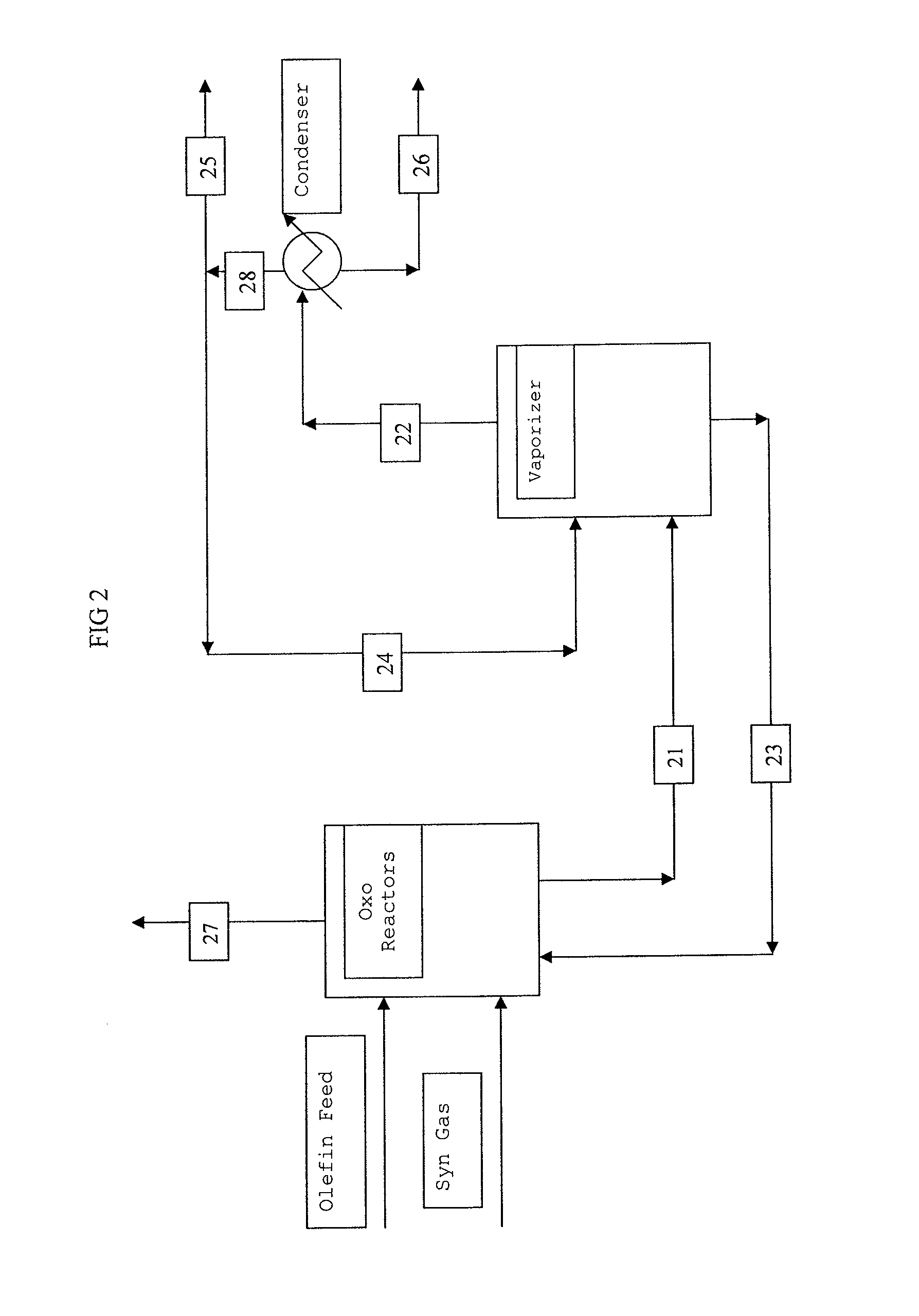Process of controlling heavies in a recycle catalyst stream
a technology of recycle catalyst and recycle stream, which is applied in the direction of physical/chemical process catalyst, organic compound/hydride/coordination complex catalyst, separation process, etc., can solve the problems of high conversion rate, high cost of refrigeration unit, and condensation of overhead stream taken from vaporizer
- Summary
- Abstract
- Description
- Claims
- Application Information
AI Technical Summary
Benefits of technology
Problems solved by technology
Method used
Image
Examples
specific embodiments
EXAMPLE 1 (E-1)
[0117]With reference to FIG. 2, a flow diagram is presented illustrating an embodiment of this invention for a hydroformylation process with subsequent separation of catalyst and aldehyde product from the hydroformylation product stream, and with recycle of a liquid catalyst stream back to the hydroformylation process. The process illustrated in FIG. 2 is modeled using ASPEN Plus software available from ASPEN Technology, Inc. of Cambridge, Mass., USA. The model assumes hydroformylation of a C4 raffinate II stream comprising 1-butene, 44 percent; cis-2-butene, 10 percent; trans-2-butene, 24 percent; isobutylene, 2 percent; and butane, 20 percent, by weight, with carbon monoxide and hydrogen in the presence of a rhodium-organobisphosphite ligand complex catalyst of Ligand D. As shown in Table 1, the ASPEN model provides mass balances for each stream of FIG. 2.
[0118]Referring to FIG. 2 and Table 1, the Oxo unit comprises two reactors connected in series. The C4 raffinate...
example 2 (
E-2)
[0122]The hydroformylation of a C4 raffinate mixture comprising 1-butene, trans-2-butene, cis-2-butene, and butane is conducted in a reactor system identical to the one depicted in FIG. 2. The Oxo unit comprises two reactors connected in series. The reaction mixture comprises about 30 percent butane; the balance being butenes in a 70 / 30 ratio of trans-2-butene to cis-2-butene, by weight. The catalyst comprises a rhodium-dioorganophosphite ligand complex catalyst of Ligand BB. The hydroformylation reaction conditions and vaporizer conditions are reported in Table 3.
[0123]
TABLE 3Example 2 Process ConditionsHydroformylation ConditionsReactor 1Reactor 2Ligand, wt % 3.6 2.7Rhodium, ppmw108 80Temperature, ° C.8060Pressure, psig (kPa)205 (1413)201 (1386)CO partial pressure, psi (kPa)65 (448)58 (400)H2 partial pressure, psi (kPa)69 (476)69 (476)1-Butene, partial pressure, psi0.29 (2.00) 0.13 (0.90) (kPa)trans-2-Butene, partial pressure, psi27.6 (190) 6.3 (43.4)cis-2-Butene, partial p...
example 3
[0134]Referring to FIG. 8, a liquid stream of reaction medium left the hydroformylation reactor via line (82), passed through a pressure reduction valve and entered flash vessel (83), operated at 6 bar (600 kPa). Reactor off gas was introduced in vessel (83) via line (81) also comprising a pressure reduction valve. A purge gas stream (84) was taken from the flash vessel (83). These gases (mainly consisting of synthesis gas, butene and butane) were sent to a condenser operated with chilled water to recover butenes and butanes and then sent to the off-gas header. The remaining liquid phase (ca. 70° C., 43.5 t / h) was taken from the separator vessel (83) and conveyed via line (85) into the falling film evaporator (86), heated with hot water. A stripping gas (50 t / h), consisting essentially of unreacted butenes and butanes, is introduced into the falling film evaporator (86) via line (87). Falling film evaporator (86) is maintained at ca. 2.5 bar (250 kPa) and ca. 110° C. Substantially a...
PUM
| Property | Measurement | Unit |
|---|---|---|
| temperature | aaaaa | aaaaa |
| temperature | aaaaa | aaaaa |
| pressure | aaaaa | aaaaa |
Abstract
Description
Claims
Application Information
 Login to View More
Login to View More - R&D
- Intellectual Property
- Life Sciences
- Materials
- Tech Scout
- Unparalleled Data Quality
- Higher Quality Content
- 60% Fewer Hallucinations
Browse by: Latest US Patents, China's latest patents, Technical Efficacy Thesaurus, Application Domain, Technology Topic, Popular Technical Reports.
© 2025 PatSnap. All rights reserved.Legal|Privacy policy|Modern Slavery Act Transparency Statement|Sitemap|About US| Contact US: help@patsnap.com



